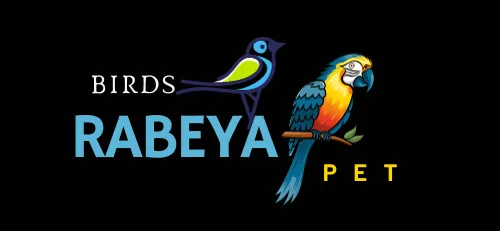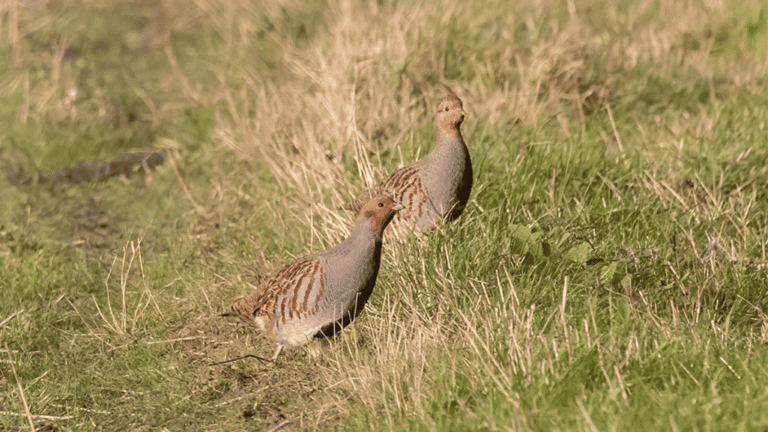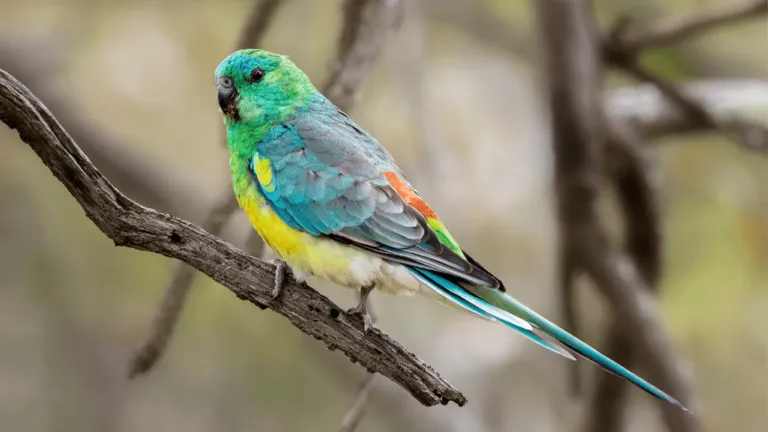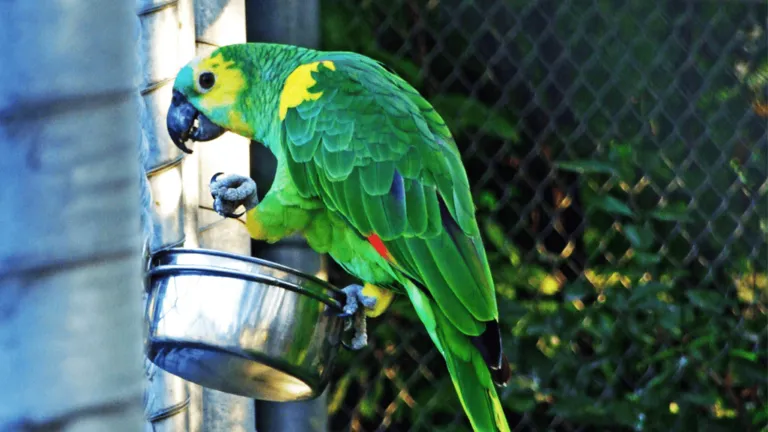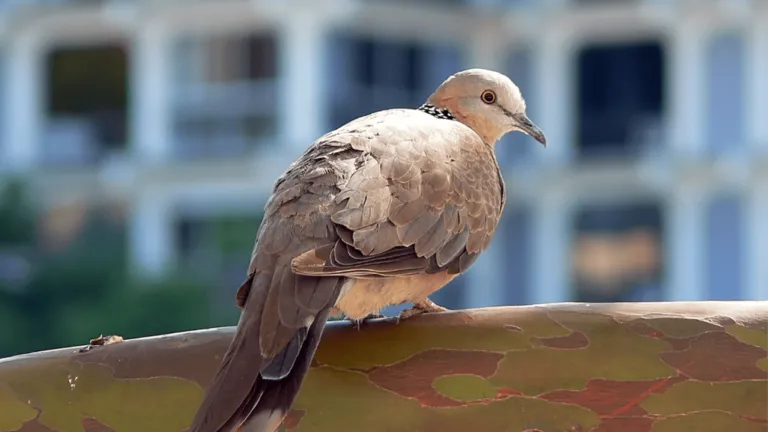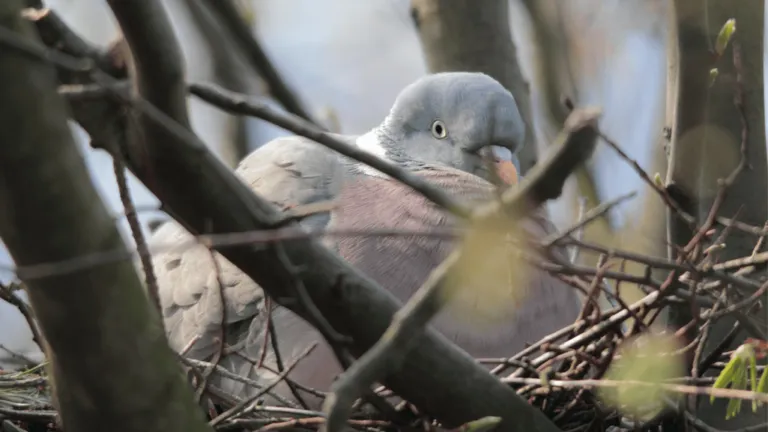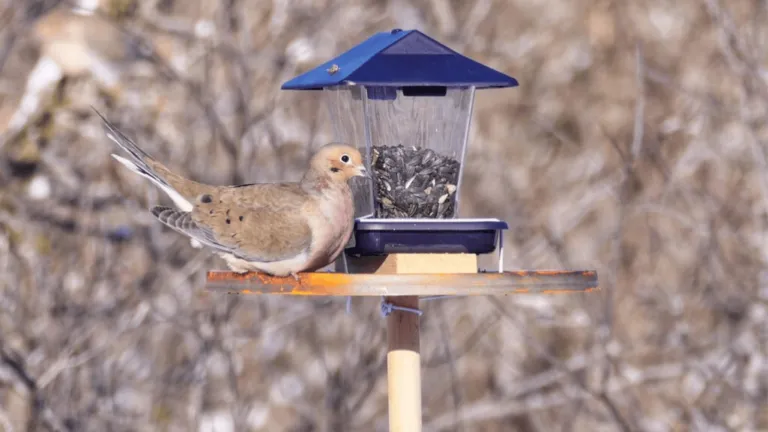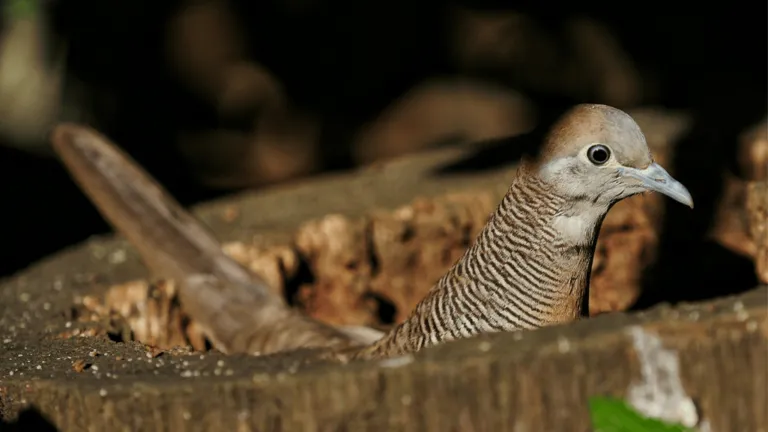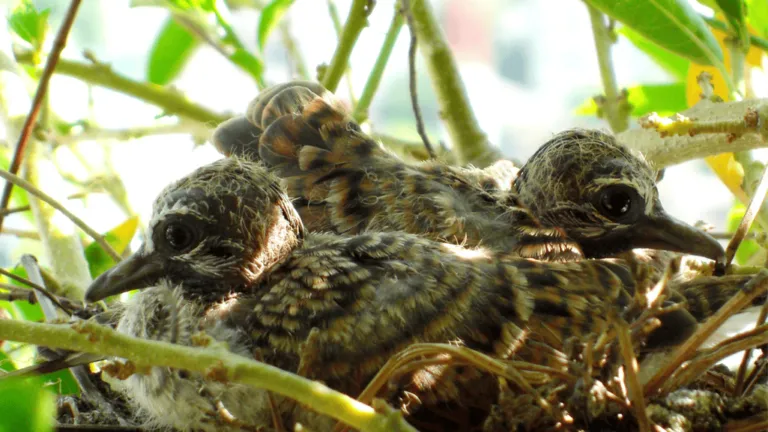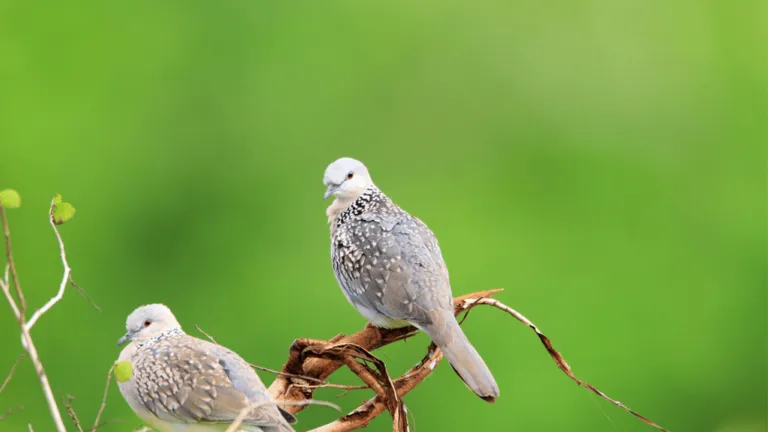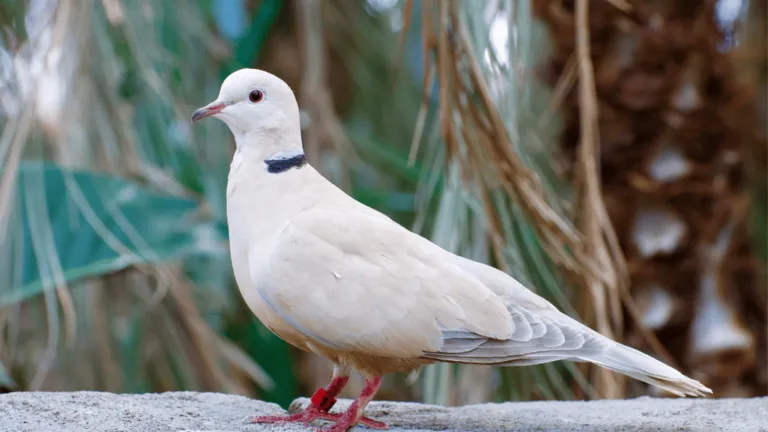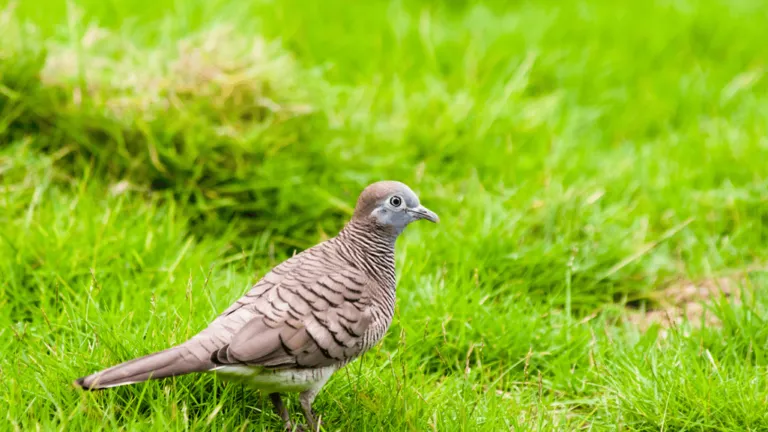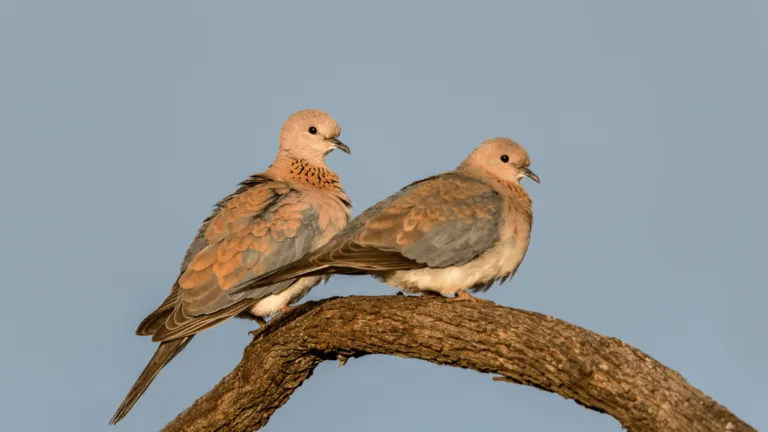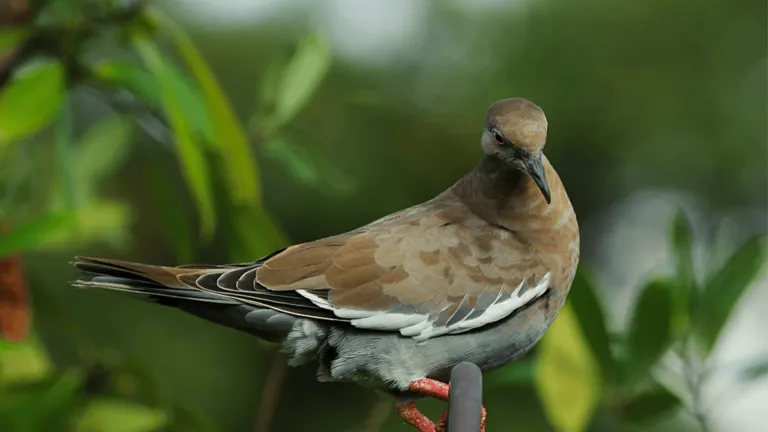The Red-eyed Dove is a beautiful bird that bird watchers love. It is known for its elegance and charm. You can find it in sub-Saharan Africa and the southwest Arabian Peninsula. It likes to be active during the day and eats both plants and animals.
This bird is listed as “Least Concern” by the IUCN Red List since 2004. It can grow up to 30 cm (12 in) long. It makes a unique six-note call. This call is often heard in peaceful places like forests, parks, and gardens.
The Red-eyed Dove has adapted well to living in cities too. It has even moved into urban areas and is doing well there.
Key Takeaways
- The Red-eyed Dove’s conservation status has been marked as Least Concern since 2004.
- No subspecies variations exist, presenting a consistent visual and behavioral profile across its range.
- The species predominantly feeds on seeds, grains, and vegetation, with a particular taste for grass seeds.
- While it largely avoids desert zones, the Red-eyed Dove thrives in areas rich in large trees and water sources.
- Its habitat includes forests, thickets, and increasingly, human environments like gardens and parks.
- Two white eggs per clutch show the continued success of the species in maintaining its population.
- Observations indicate the Red-eyed Dove’s adaptable nature, with expanding territories even into urban settings.
Introducing the Red-eyed Dove: A Bird of Beauty and Mystery
The Red-eyed Dove, known as Streptopelia semitorquata, is a bird that stands out with its beauty and mystery. It’s found in sub-Saharan Africa and is loved for its looks and how well it fits into different places.
The Scientific and Common Names
In the world of ornithology, the Red-eyed Dove is called Streptopelia semitorquata. It also goes by different names in different places, like Hua Fifi in Swahili. This shows how important it is to local people.
Unique Physical Characteristics
The Red-eyed Dove is big and sturdy, about 30 cm long and weighs 162 to 310 grams. It has a soft brown back and darker wings and tail. The belly is a deep pink that turns to pale grey near the face.
It also has a black patch on its neck, white edges, red legs, and red skin around its eyes. This makes it a standout in the bird world.
This dove is known for its gentle call and behavior. Its call adds to its charm in its natural setting. For those who want to see it, the Media Storehouse has beautiful prints of it.
With wildlife facing many threats, it’s vital to understand and appreciate birds like the Red-eyed Dove. Protecting their homes and keeping the environment safe is key. Conservationists offer advice on how to help at places like Birds Rabeya Pet.
Learning more about the Red-eyed Dove shows how important it is to our world. It’s not just beautiful but also plays a big role in its ecosystem. It helps keep our planet balanced and healthy.
The Red-eyed Dove’s Daily Life: Understanding Their Diurnal Patterns
The Red-eyed Dove is a key bird that is active during the day. It shows amazing day-active behaviors tied to its eating and social life. These birds fit well into their surroundings, changing easily with the daylight.
Dietary Habits: An Omnivorous Diet
The Red-eyed Dove diet is quite varied, including seeds and small insects. They eat maize, sunflower, castor seed, and millet mainly. They also eat termites and berries sometimes. This shows how adaptable they are and how important they are in controlling pests and spreading seeds.
These birds eat during the cooler parts of the day. They do this in the early mornings and late afternoons. This helps them stay efficient and avoid the heat of the day.
Social Behaviors: Solitary or in Pairs
The Red-eyed Dove behavior can be seen alone or in pairs. They are often alone but can be found in pairs or groups during feeding. This helps them get more food and protect their territory.
They are interesting to watch because they can be quite tolerant of each other during feeding. This shows how important community is, even for birds that usually like to be alone.
| Feeding Item | Frequency |
|---|---|
| Seeds (Maize, Sunflower, Millet) | High |
| Small Insects (Termites) | Moderate |
| Berries | Occasional |
Learning about the feeding habits of birds like the shaft-tail finch helps us understand their connection to their food and homes. This knowledge is key for protecting these birds and their homes.
Unveiling the Red-eyed Dove Habitat: From Sub-Saharan Africa to Arabian Peninsula
The Red-eyed Dove range shows how adaptable and resilient these African birds are. They live in many places across sub-Saharan Africa, where there’s lots of greenery and big water. They like living in everything from dense forests to city edges, showing how flexible they are.
Most of these doves live in the lush areas of sub-Saharan Africa. But, they also live in the southwest Arabian Peninsula, even though it’s very dry. They make do with the few green spots they find, like oases and parks, which are similar to their African homes. This shows how the Red-eyed Dove range can adapt to different places, but they avoid the driest deserts.
Learning more about the Columbidae family shows that the Red-eyed Dove is not alone in its adaptability. Other birds in the family also live in many different places. They have learned to live with people, which has helped them spread out and make new homes.
| Region | Habitat Type | Presence |
|---|---|---|
| Sub-Saharan Africa | Forests, Urban Parks, Gardens | Common |
| Southwest Arabian Peninsula | Oases, Manicured Parklands | Moderate |
The Red-eyed Dove’s success in different places shows how well they can adapt. It also shows why we need to keep working to protect their homes. By doing this, we can make sure these beautiful African birds keep adding to our world’s variety.
Decoding the Red-eyed Dove’s Communication: Calls and Songs
The world of Red-eyed Dove calls shows us how birds talk to each other. They have a special six-note pattern that shows how complex their communication is. These calls are key to their social life and daily activities.
Characteristic Six-Note Pattern
The Red-eyed Dove’s call has six notes, with the last two being very important. These notes help them claim their territory and find a mate. This call makes them stand out from other birds in the Columbidae family.
Vocalizations During Different Times of Day
Red-eyed Doves don’t just talk during the day. They call a lot at dawn, twilight, and even at night under the moon. This shows they might be more active at night than we thought. It changes what we know about avian vocalization.
| Species Name | Length (cm) | Typical Behavior |
|---|---|---|
| Mourning Dove | 30 | Extensive day-time calling |
| Collared Dove | 32 | Less frequent calling, mostly at dusk |
| European Turtle Dove | 25 | Day-time calling with distinct patterns |
| Woodpigeon | 42 | Loudest calls among peers, majorly day-time |
| Red-eyed Dove | N/A | Day to twilight, including occasional nocturnal vocalizations |
Learning about Red-eyed Dove calls helps us understand bird communication better. It shows us the different ways birds talk to each other. These calls are crucial for finding a mate, defending territory, and surviving.
Mating Rituals and Nesting Practices of the Red-eyed Dove
The Red-eyed Dove has special ways of reproducing that help it survive and grow. These include their mating rituals and how they build nests. We’ll look into their nesting habits and how both parents take care of their young. This will help us understand how they reproduce.
Construction of Nests in Trees
Constructing Safe Havens
Red-eyed Doves like to make their nests in trees or thick plants. This keeps them safe from dangers. They use twigs and grass to build a strong nest for laying eggs. Sometimes, they even use nests made by other birds.
Ensuring Protection and Warmth
In places like the sub-Saharan Africa, these doves pick nesting spots that are good for their babies. They choose spots in trees that protect the nest from predators and harsh weather. This helps more of their babies survive.
Involvement of Both Parents in Incubation
Shared Parental Responsibilities
Red-eyed Doves are special because both parents help with the eggs. They take turns keeping the eggs warm, which helps more eggs hatch. They work together in many ways beyond just keeping the eggs warm.
Nurturing the Next Generation
After the eggs hatch, both parents feed and protect the babies. They make sure the babies get enough food and stay warm until they can fly on their own. This is important for about two to three weeks.
Let’s compare how Red-eyed Doves and Mourning Doves nest. This shows the differences in their nesting habits.
| Characteristics | Red-eyed Dove | Mourning Dove |
|---|---|---|
| Average Eggs Per Nest | 2 | 2 |
| Incubation Period | 14-15 days | 14-15 days |
| Parental Involvement | Both parents | Both parents |
| Fledgling Period | 12-14 days | Approximately 15 days |
| Nests Reused in a Season | Up to 5 sets | Up to 5 sets |
Learning about how doves nest and reproduce shows us their complex lives. It also shows why we need to protect their homes. Helping these birds is important for their survival.
Diet and Foraging Behaviors of the Red-eyed Dove
The Red-eyed Dove is found across sub-Saharan Africa. It has unique eating habits that help it survive in different places. These habits show how the species adapts and interacts with its environment.
Variety of Seeds and Insects in Diet
The Red-eyed Dove eats many seeds, which helps spread seeds of many plants. They are good at finding seeds on the ground with their beaks. They also eat bublets and small fruits, which are important for their diet.
During some seasons, they eat termites too. This is important when they need more food, like during breeding or when food is hard to find.
Feeding Times: Early Morning and Late Afternoon
The Red-eyed Dove forages in the cooler parts of the day to save energy and avoid predators. They mostly forage in the early morning and late afternoon. This helps them use their energy well and find termites and other insects that are active then.
| Feeding Behavior | Primary Foods | Feeding Times |
|---|---|---|
| Ground Foraging | Seeds, small fruits, bublets | Early morning, late afternoon |
| Insect Consumption | Termites | Early morning, late afternoon (peak insect activity) |
The Intricate Social Structure of Red-eyed Doves
Red-eyed Doves show us how birds interact in their groups. They often eat together but mostly stick to pairs or short friendships. This simple social life is a smart way to live in their world.
People might think birds like Red-eyed Doves live in complex groups like some other birds. But they don’t. They mainly interact to survive, not for fun. This is seen in how they find mates or protect their space.
They make friends for a short time. After breeding season, they often go back to being alone. This shows they only stick together when it’s needed.
Living alone or with a partner is their usual way. It’s like how some artists think about birds and human feelings. For example, musings on when doves sing connect doves with human feelings.
So, Red-eyed Doves live simply, not for complex social reasons. By watching them, we learn about survival strategies. These strategies are similar to how humans sometimes work together and sometimes prefer to be alone.
Exploring Red-eyed Dove Behavior: From Ground Foraging to Moonlit Calls
The Red-eyed Dove is common in Sub-Saharan Africa and the Arabian Peninsula. It has developed behaviors to survive. These birds adapt by foraging on the ground. This choice lets them find seeds and other food not available to birds that only live in trees or fly.
They forage by scratching and pecking in leaf litter under trees. This way, they avoid predators. It’s a smart move for their survival.
Adaptation to Ground Foraging
The Red-eyed Dove has learned to forage on the ground. Not all birds do this, but it works well for them. They look for places where seeds are plentiful and feel safe.
This skill helps them succeed in different environments. It shows how adaptable and resilient they are.
Nocturnal Vocal Activity
At night, the Red-eyed Dove becomes more active. It sings in the quiet, cooler hours. Moonlight seems to make them vocal, showing a side of their behavior not seen during the day.
These birds call out in the dark. Their voices sound mysterious. This could help them defend their territory or find a mate.
In conclusion, the Red-eyed Dove is fascinating because of its unique behaviors. It forages on the ground and sings at night. These traits help it survive and thrive. It’s a great example of how birds adapt and survive in our world.

